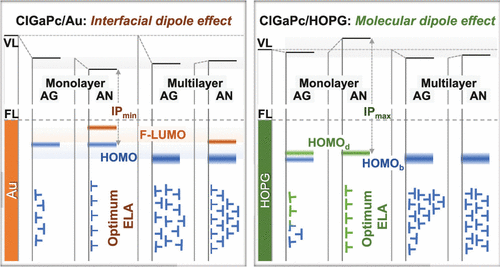当前位置:
X-MOL 学术
›
ACS Appl. Mater. Interfaces
›
论文详情
Our official English website, www.x-mol.net, welcomes your
feedback! (Note: you will need to create a separate account there.)
Evolution of Electronic Structures of Polar Phthalocyanine-Substrate Interfaces.
ACS Applied Materials & Interfaces ( IF 8.3 ) Pub Date : 2020-09-11 , DOI: 10.1021/acsami.0c12614 Subhankar Mandal 1 , Manabendra Mukherjee 2 , Satyajit Hazra 1
ACS Applied Materials & Interfaces ( IF 8.3 ) Pub Date : 2020-09-11 , DOI: 10.1021/acsami.0c12614 Subhankar Mandal 1 , Manabendra Mukherjee 2 , Satyajit Hazra 1
Affiliation

|
The electronic structures and core-level spectra of chlorogallium phthalocyanine (ClGaPc) molecules of different thicknesses (submonolayer to multilayer) adsorbed on a polycrystalline Au substrate and a highly oriented pyrolytic graphite (HOPG) substrate, before and after thermal annealing, were investigated using photoelectron spectroscopic techniques for better understanding the charge-transfer properties. The energy-level diagrams (ELDs) of the ClGaPc thin films are found to evolve with film thickness, substrate nature, and thermal annealing. The interfacial dipole moment in the active Au substrate and the molecular dipole moment in the inactive HOPG substrate mainly dictate the ELD. Annealed monolayer films on both the substrates seem to adopt a similar well-ordered Cl-up orientated molecular organization, which is quite interesting, as it certainly indicates a substrate-nature-independent energy minimum configuration. The strong interaction of the active Au substrate gives rise to additional charge transfer and state transfer (of Ga) as evident from the formation of a former lowest unoccupied molecular orbital (F-LUMO) level in the highest occupied molecular orbital (HOMO) region and a low binding energy peak in the Ga 2p3/2 core level. The presence of strong F-LUMO and molecular-dipole-related HOMOd levels in the predicted monolayer of well-ordered Cl-up oriented molecules on the Au and HOPG substrates, respectively, creates the optimum energy-level alignment (ELA) for both the systems, while the opposite shift of the vacuum levels in two different substrates makes the ionization potential (IP) for such a monolayer either minimum (on the Au substrate) or maximum (on the HOPG substrate), which is useful information for tuning the charge injection across the interface in organic semiconductor-based devices.
中文翻译:

极性酞菁-底物界面电子结构的演变。
使用光电子研究了热退火前后吸附在多晶Au衬底和高取向热解石墨(HOPG)衬底上的不同厚度(亚单层到多层)的厚度不同的氯镓酞菁(ClGaPc)分子的电子结构和核心能级谱。光谱技术,以更好地了解电荷转移性质。发现ClGaPc薄膜的能级图(ELD)随着膜厚度,衬底性质和热退火而变化。活性金基质中的界面偶极矩和非活性HOPG基质中的分子偶极矩主要决定了ELD。在两种基材上退火的单层膜似乎采用了相似的有序的Cl-up取向分子组织,这非常有趣,因为它肯定表明了与底物性质无关的最低能量配置。活性Au底物的强相互作用会引起额外的电荷转移和(Ga)态转移,这从在最高占据分子轨道(HOMO)区域中以前最低的未占据分子轨道(F-LUMO)能级形成以及Ga 2p中的低结合能峰3/2核心级别。在Au和HOPG基底上,在预测的有序Cl-up取向分子的预测单层中分别存在强F-LUMO和分子偶极子相关的HOMO d水平,可为两者创造最佳的能级比对(ELA)在两个不同基板上真空度的相反移动使这种单层的电离电势(IP)最小(在Au基板上)或最大(在HOPG基板上),这对于调节在基于有机半导体的设备中通过界面注入电荷。
更新日期:2020-10-07
中文翻译:

极性酞菁-底物界面电子结构的演变。
使用光电子研究了热退火前后吸附在多晶Au衬底和高取向热解石墨(HOPG)衬底上的不同厚度(亚单层到多层)的厚度不同的氯镓酞菁(ClGaPc)分子的电子结构和核心能级谱。光谱技术,以更好地了解电荷转移性质。发现ClGaPc薄膜的能级图(ELD)随着膜厚度,衬底性质和热退火而变化。活性金基质中的界面偶极矩和非活性HOPG基质中的分子偶极矩主要决定了ELD。在两种基材上退火的单层膜似乎采用了相似的有序的Cl-up取向分子组织,这非常有趣,因为它肯定表明了与底物性质无关的最低能量配置。活性Au底物的强相互作用会引起额外的电荷转移和(Ga)态转移,这从在最高占据分子轨道(HOMO)区域中以前最低的未占据分子轨道(F-LUMO)能级形成以及Ga 2p中的低结合能峰3/2核心级别。在Au和HOPG基底上,在预测的有序Cl-up取向分子的预测单层中分别存在强F-LUMO和分子偶极子相关的HOMO d水平,可为两者创造最佳的能级比对(ELA)在两个不同基板上真空度的相反移动使这种单层的电离电势(IP)最小(在Au基板上)或最大(在HOPG基板上),这对于调节在基于有机半导体的设备中通过界面注入电荷。











































 京公网安备 11010802027423号
京公网安备 11010802027423号